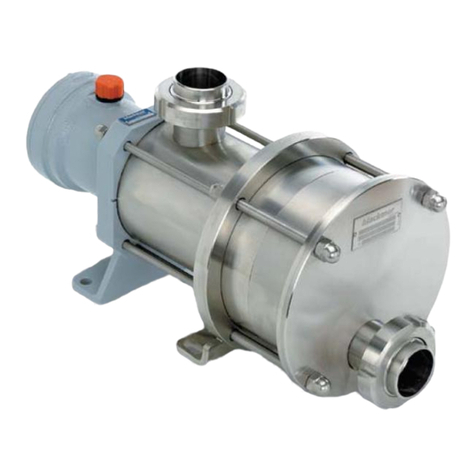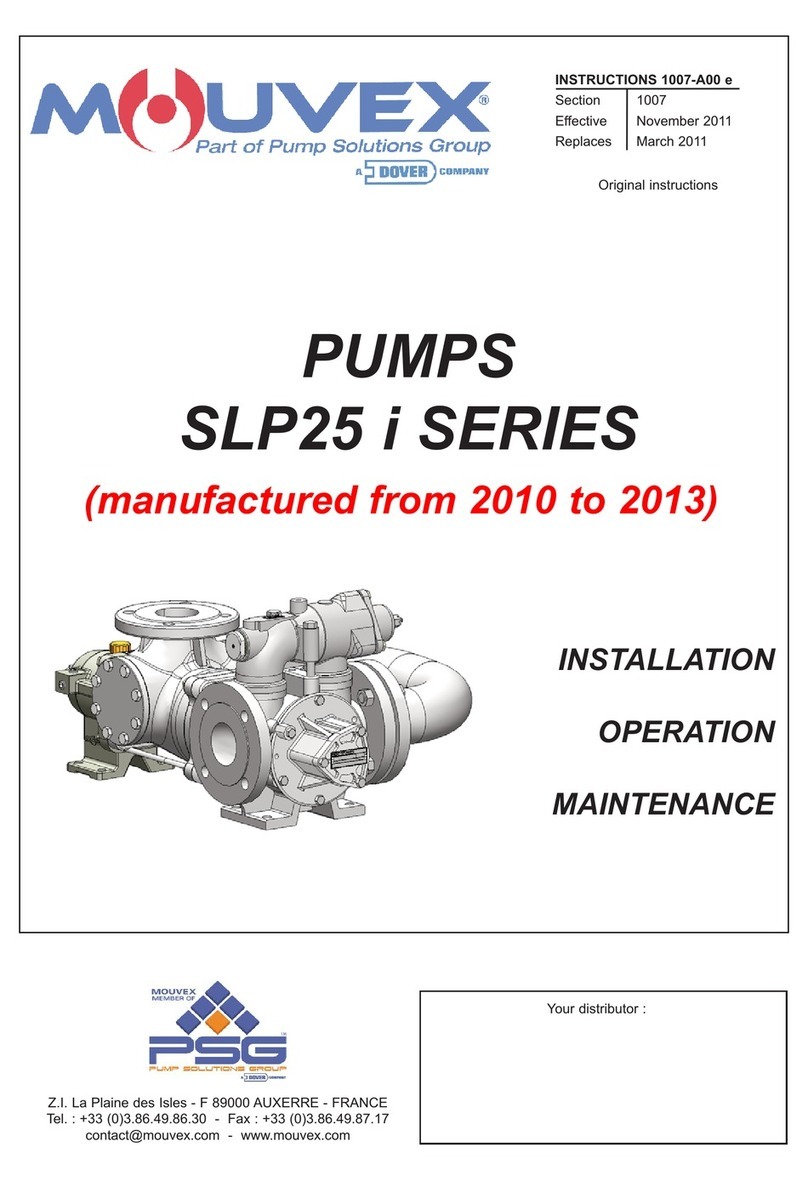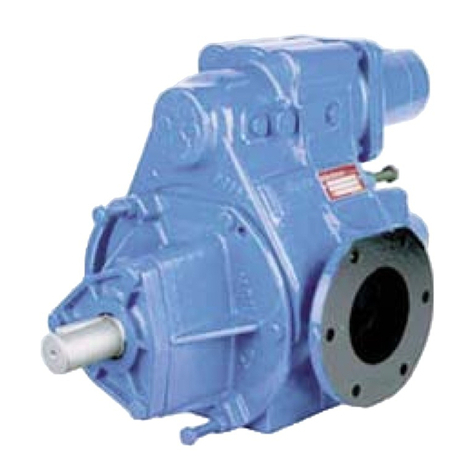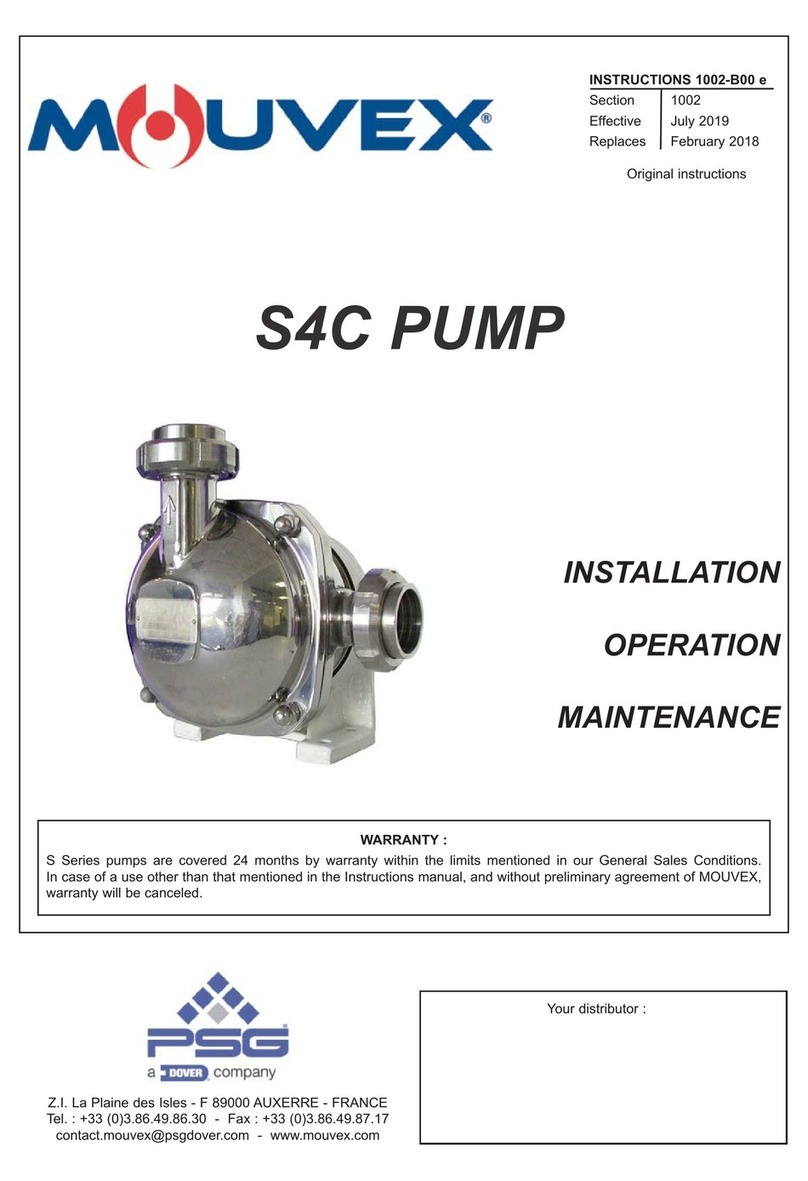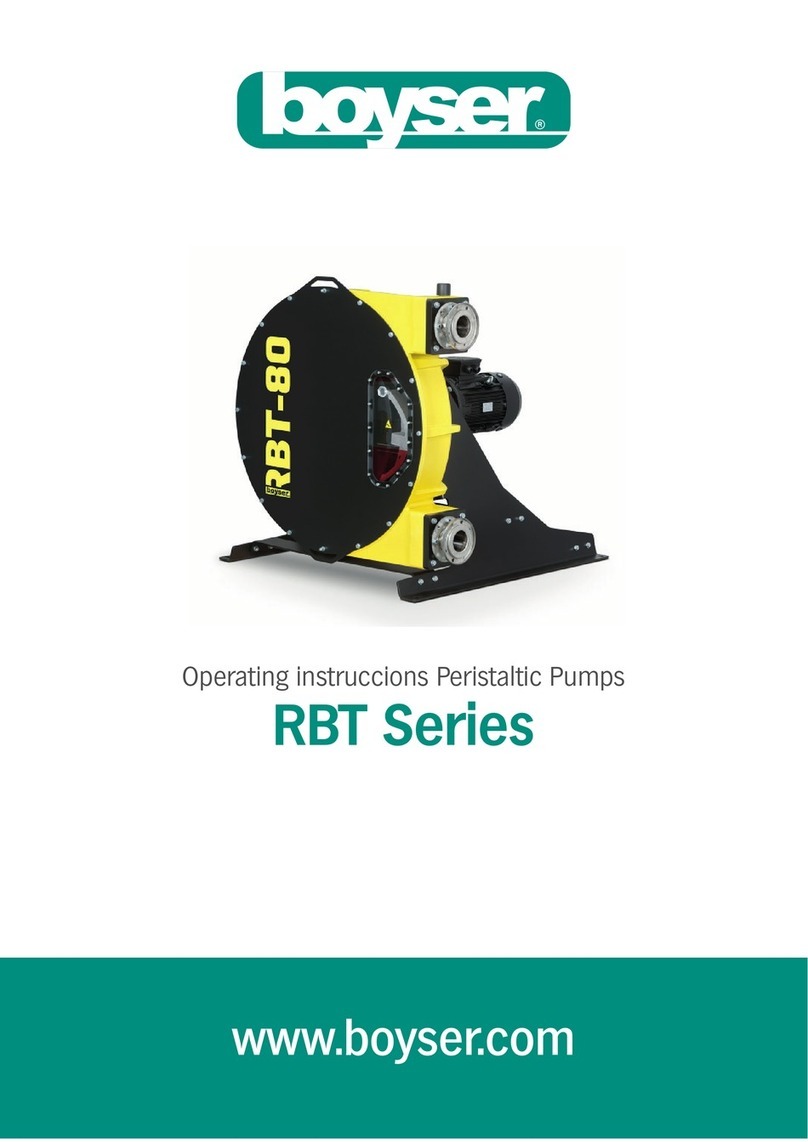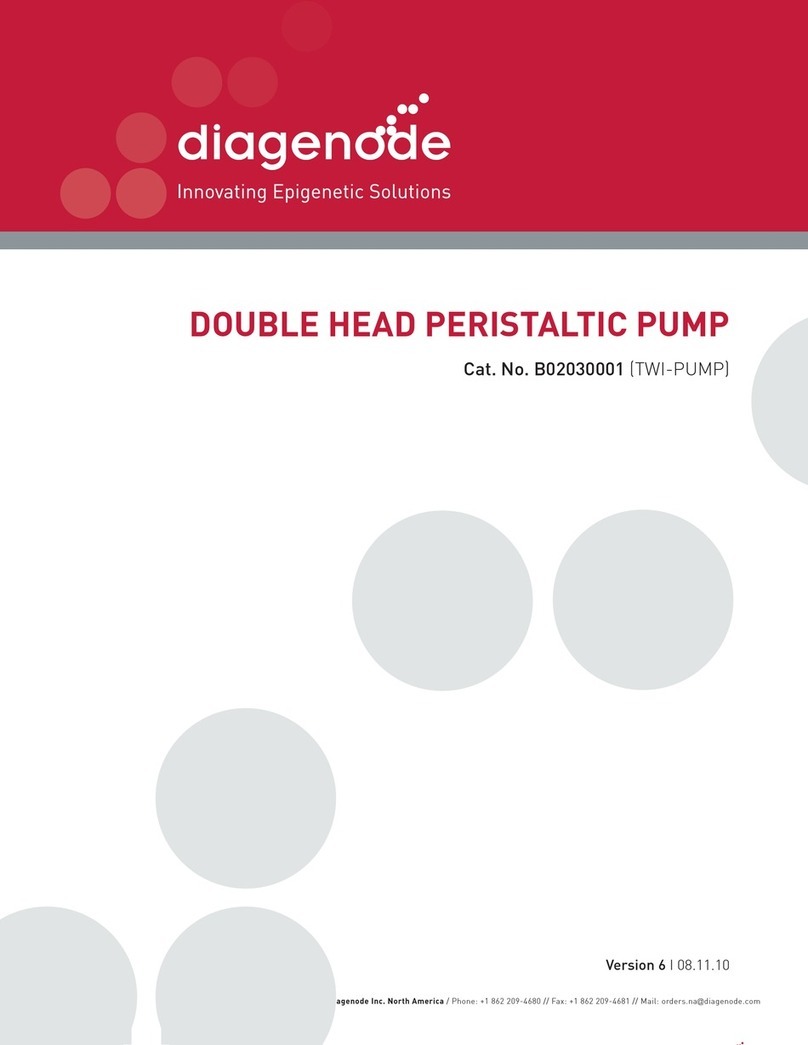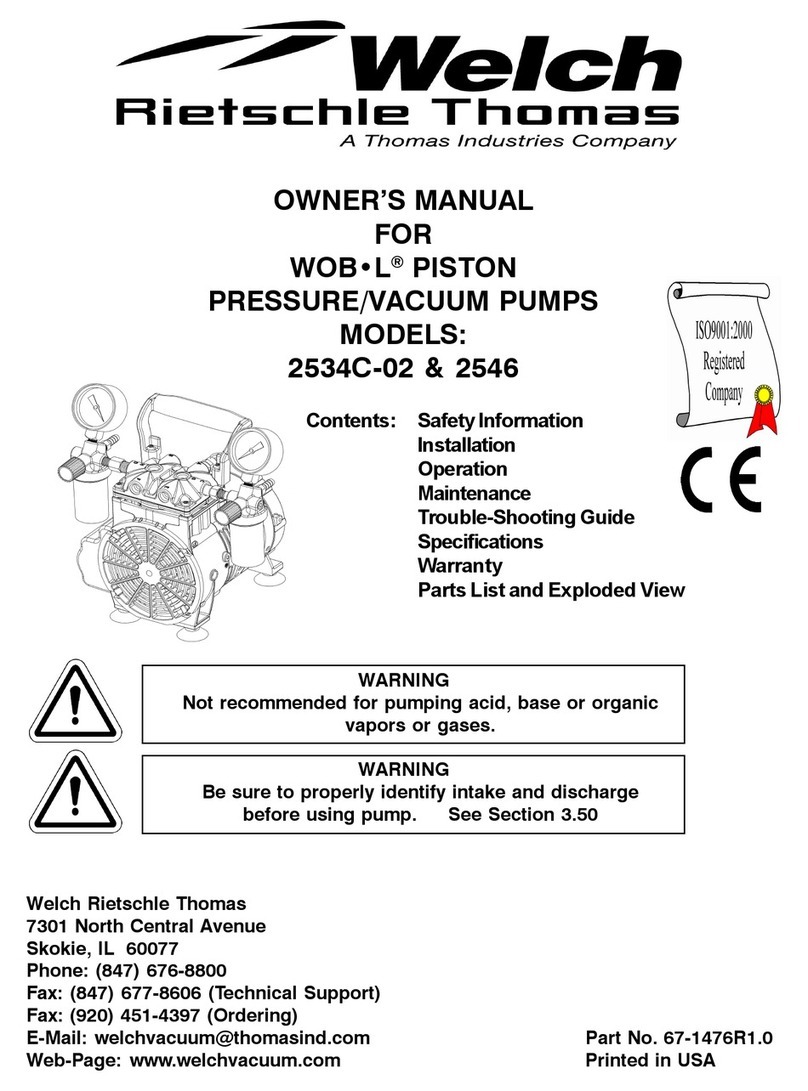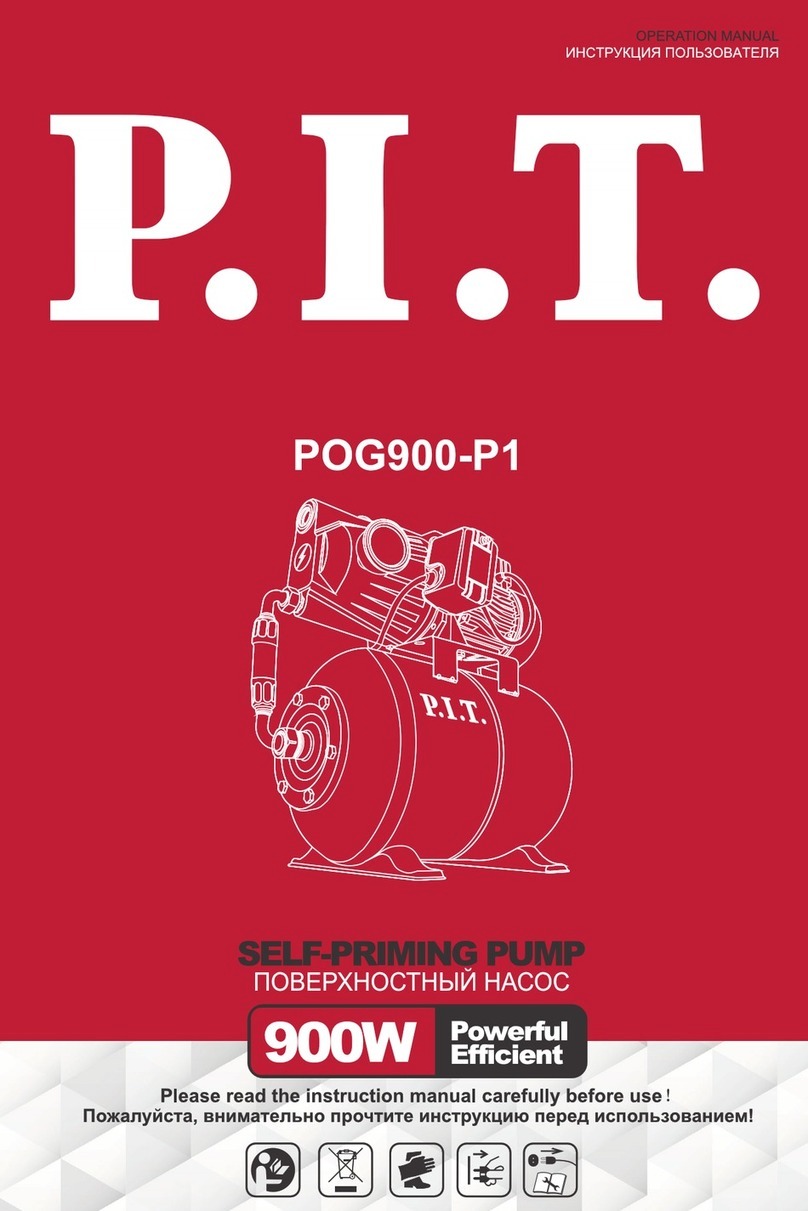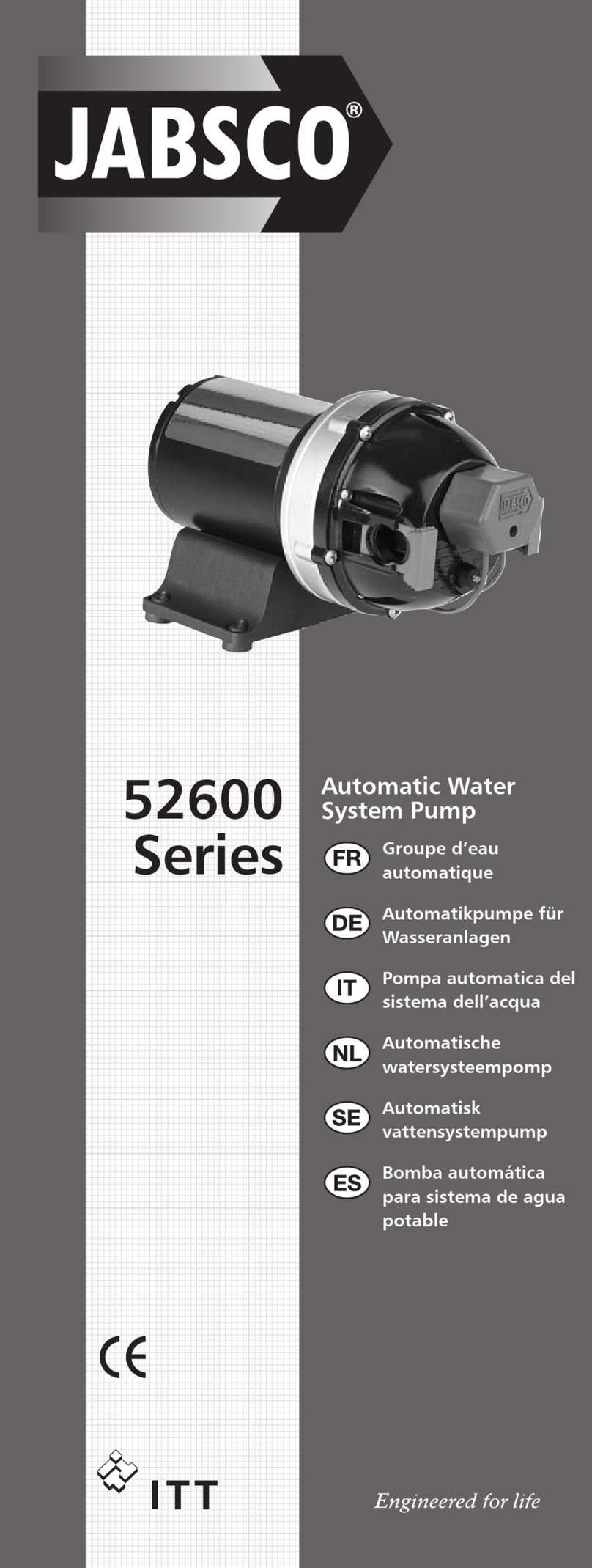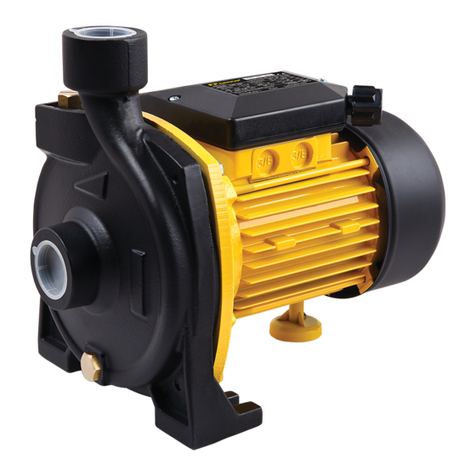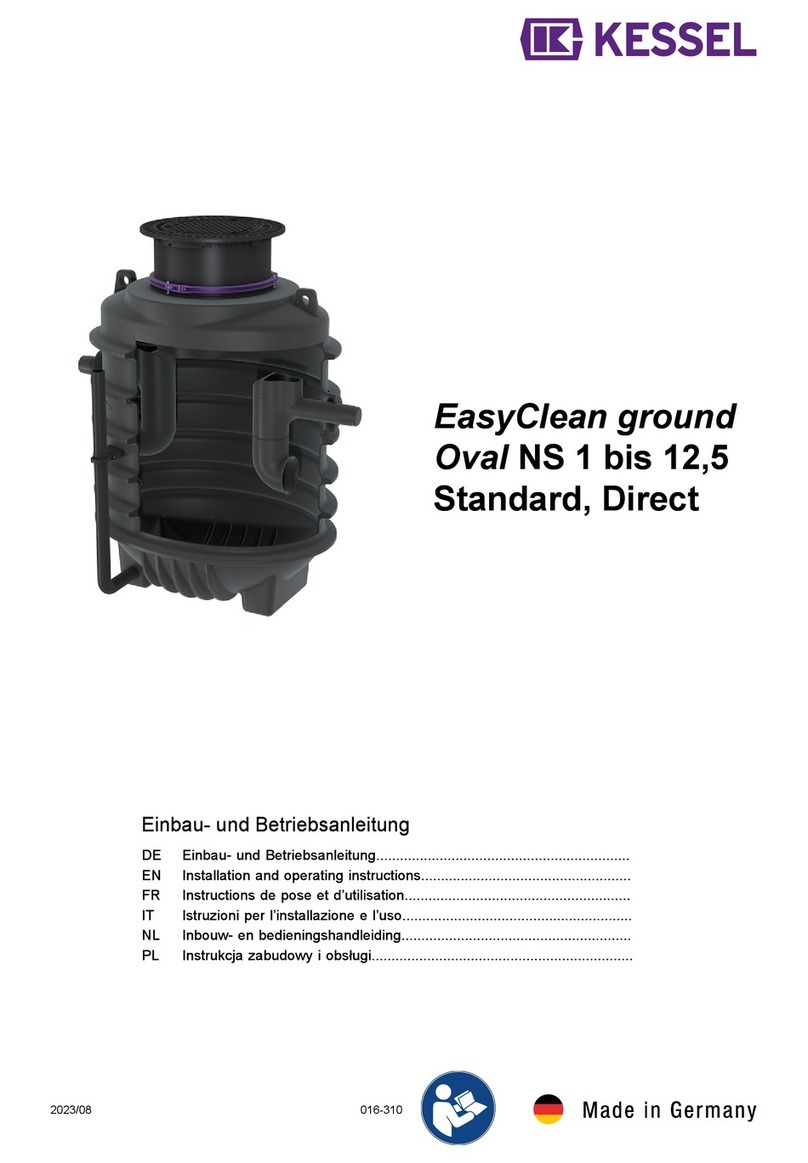Mouvex SLS4 i User manual

SLS4 i - SLS8 i
PUMPS
INSTALLATION
OPERATION
MAINTENANCE
INSTRUCTIONS 1004-E00 e
Section 1004
Effective February 2018
Replaces December 2016
Original instructions
Your distributor :
Z.I. La Plaine des Isles - F 89000 AUXERRE - FRANCE
Tel. : +33 (0)3.86.49.86.30 - Fax : +33 (0)3.86.49.87.17
WARRANTY :
SL Series pumps are covered 24 months by warranty within the limits mentioned in our General Sales Conditions.
In case of a use other than that mentioned in the Instructions manual, and without preliminary agreement of MOUVEX,
warranty will be canceled.

2/31
NT 1004-E00 02 18 SLS4 i - SLS8 i e
ECCENTRIC PISTON PUMP
MOUVEX PRINCIPLE
SAFETY INSTRUCTIONS, STORAGE, INSTALLATION AND MAINTENANCE
SLS4 i - SLS8 i MODELS
TECHNICAL CHARACTERISTICS
- Maximum pump speed : 750 rpm
- Running temperatures :
• ambient ......................................................-15°C → .+ 40°C
• continuous pomped product.......................-15°C → .+100°C
• washing / rinsing / sterilisation product...... 0°C → .+121°C
• heating fluid (jacket)...................................-15°C → .+180°C
- Maximum suction pressure :
• In normal use, the suction pressure must be higher than the
required NPSH and less than 1,5 barg (21,75 psig).
• During CIP/SIP of the pump, the suction pressure must not
exceed 3 barg (43,5 psig).
• Pump stopped, the pressure must not exceed 6 barg
(87 psig).
- Acceptable maximal differential pressure :
• SLS4 i ..........................10 bar (145 psi)
• SLS8 i .......................... 6 bar (87 psi)
- Maximum pressure jacket : 5 barg (72,50 psig)
- Cylinder capacity :
• SLS4 i ..........................0,108 litre
• SLS8 i ..........................0,178 litre
1. CODIFICATION . . . . . . . . . . . . . . . . . . . . . . . . . . . . . . . . .3
2. OVERALL DIMENSIONS . . . . . . . . . . . . . . . . . . . . . . . . . .4
3. INSTALLATION . . . . . . . . . . . . . . . . . . . . . . . . . . . . . . . . .9
3.1 Installation design . . . . . . . . . . . . . . . . . . . . . . . . . . . . .9
3.2 Orientation of the pump ports . . . . . . . . . . . . . . . . . . .10
3.3 Direction of rotation . . . . . . . . . . . . . . . . . . . . . . . . . . .10
3.4 Protection of the pump installation . . . . . . . . . . . . . . .11
3.5 Hoisting devices . . . . . . . . . . . . . . . . . . . . . . . . . . . . .11
3.6 Unit Assembly . . . . . . . . . . . . . . . . . . . . . . . . . . . . . . .11
4. UTILISATION . . . . . . . . . . . . . . . . . . . . . . . . . . . . . . . . .14
4.1 Noise level . . . . . . . . . . . . . . . . . . . . . . . . . . . . . . . . .14
4.2 Commissioning . . . . . . . . . . . . . . . . . . . . . . . . . . . . . .14
4.3 Dry running . . . . . . . . . . . . . . . . . . . . . . . . . . . . . . . . .14
4.4 Pump stop . . . . . . . . . . . . . . . . . . . . . . . . . . . . . . . . . .14
4.5 Scrapping . . . . . . . . . . . . . . . . . . . . . . . . . . . . . . . . . .14
5. CLEAN IN PLACE (CIP) & STERILISATION IN PLACE
(SIP) . . . . . . . . . . . . . . . . . . . . . . . . . . . . . . . . . . . . . . . .15
5.1 General . . . . . . . . . . . . . . . . . . . . . . . . . . . . . . . . . . . .15
5.2 CIP circuit recommended . . . . . . . . . . . . . . . . . . . . . .15
5.3 Pumps arranged in series . . . . . . . . . . . . . . . . . . . . . .15
5.4 Pumps arranged in parallel . . . . . . . . . . . . . . . . . . . . .16
5.5 Successive cycles . . . . . . . . . . . . . . . . . . . . . . . . . . . .17
5.6 Sterilisation In Place (SIP) . . . . . . . . . . . . . . . . . . . . .17
6. MAINTENANCE . . . . . . . . . . . . . . . . . . . . . . . . . . . . . . . .17
6.1 Necessary tools . . . . . . . . . . . . . . . . . . . . . . . . . . . . .17
7. OPENING OF THE PUMP . . . . . . . . . . . . . . . . . . . . . . . .18
7.1 Assembly / Dismantling . . . . . . . . . . . . . . . . . . . . . . . .18
7.2 Checking of parts . . . . . . . . . . . . . . . . . . . . . . . . . . . .19
8. ASSEMBLY OF CYLINDER/PISTON . . . . . . . . . . . . . . . .20
9. PROTECTION OF THE BELLOWS . . . . . . . . . . . . . . . . . .22
10. DISMANTLING OF THE BELLOWS . . . . . . . . . . . . . . . .23
11. CHANGING THE ORIENTATION OF THE PORTS . . . . .26
11.1 Discharge port . . . . . . . . . . . . . . . . . . . . . . . . . . . . . .26
11.2 Suction port . . . . . . . . . . . . . . . . . . . . . . . . . . . . . . . .26
12. DRAINING OF BEARING . . . . . . . . . . . . . . . . . . . . . . . .27
13. STORAGE . . . . . . . . . . . . . . . . . . . . . . . . . . . . . . . . . . .28
13.1 Short duration (≤ 1 month) . . . . . . . . . . . . . . . . . . . .28
13.2 Long duration (> 1 month) . . . . . . . . . . . . . . . . . . . .28
13.3 Restarting . . . . . . . . . . . . . . . . . . . . . . . . . . . . . . . . .28
14. TROUBLESHOOTING . . . . . . . . . . . . . . . . . . . . . . . . . .29
15. CERTIFICATE OF CONFORMITY . . . . . . . . . . . . . . . . .31
TABLE OF CONTENTS Page
USED PRESSURE UNITS
Unit without suffix :
Differential pressure, for example, pressure difference between
equipment suction and discharge.
Unit with suffix "a" :
Absolute pressure.
Unit with suffix "g" :
Gauge pressure, given regarding to atmospheric pressure
(~101325 Pa, taken at 1 bar / 14,5 psi in this IOM).
Pompe
P
asp
P
re
f
Psuc Pdis
Pump
Example :
Psuc = -0,2 barg = 0,8 bara
Pdis = 8,8 barg = 9,8 bara
∆P = Pdis - Psuc = 9 bar
Definition of safety symbols
This is a SAFETY ALERT SYMBOL.
When you see this symbol on the product, or in the manual,
look for one of the following signal words and be alert to the
potential for personal injury, death or major property damage.
Warns of hazards that WILL cause serious personal injury,
death or major property damage.
Warns of hazards that CAN cause serious personal injury,
death or major property damage.
Warns of hazards that CAN cause personal injury or property
damage.
NOTICE
Indicates special instructions which are very important and
must be followed.
DANGER
WARNING
CAUTION

3/31
NT 1004-E00 02 18 SLS4 i - SLS8 i e
SLS
4- 4 m3/h
8- 8 m3/h
I Standard
ST- Standard
EV- Heating jacket
VT- FKM
CVT- FKM encapsulated FEP
AF50- Flanges DIN11864-BF-A D50
CLAS51- Connections CLAMP ASME BPE-2009 D51
SMS51- Connections SMS1145 D51
DIN50- Connections DIN11851 D50
- Without
BMS- Bellows Monitoring System
BMSA- ATEX Bellows Monitoring System
Transmission security
Connections-Flanges
Seals
Conception
Flowrate
Temperature
4- I ST- VT- AF50- -
1. CODIFICATION

4/31
NT 1004-E00 02 18 SLS4 i - SLS8 i e
2. OVERALL DIMENSIONS
Pump plate
Filling / Breather
Draining
Oil level
P
R
V
N
SLS4 i - SLS8 i
with connections
DN A B C D E F
499 177 26728749
51 [19.646][6.969][10.512][11.299]109 129 51 x1,25 [109]
[2.008]516 194 284 304 [4.291][5.079][2.008 x0.049]51
[20.315] [7.638][11.181][11.969][113]
499 177 26728749
51 [19.646][6.969][10.512][11.299]109 129 52 x2[109]
[2.008]516 194 284 304 [4.291][5.079][2.047x0.079]51
[20.315] [7.638][11.181][11.969][113]
499 177 26728749
50 [19.646][6.969][10.512][11.299]109 129 55 x2,5[109]
[1.969]516 194 284 304 [4.291][5.079][2.165 x0.098]51
[20.315] [7.638][11.181][11.969][113]
DIN 11851
SLS4
SLS8
ODx T
SMS 1145
SLS4
SLS8
Clamp
ASME BPE
2009
SLS4
SLS8
Connections
Weight
kg [lb]
CAUTION : When welding the connections, the bellows should be protected.
SECTION A-A

5/31
NT 1004-E00 02 18 SLS4 i - SLS8 i e
2. OVERALL DIMENSIONS (continued)
Pump plate
Filling / Breather
Draining
Oil level
P
R
V
N
SLS4 i - SLS8 i
with flanges
DN A B C D E F ØG ØLØK
499 177 26728749,5
50 [19.646][6.969][10.512][11.299]109 129 53 x1,594 9 77 [110]
[1.969]516 194 284 304 [4.291][5.079][2.087x0.059][3.701][0.354][3.031]51,5
[20.315] [7.638][11.181][11.969][114]
ODxT
DIN11864
BFͲA
SLS4
SLS8
Flanges
Weight
kg [lb]
CAUTION : When welding the connections, the bellows should be protected.
SECTION A-A
4 x Ø L on Ø K

6/31
NT 1004-E00 02 18 SLS4 i - SLS8 i e
2. OVERALL DIMENSIONS (continued)
SLS4 i - SLS8 i
with heating jacket
JACKET CONNECTION
The entry connection may be connected to one or two points. NOTICE :
For the other sides, see the specific overall dimension plan for the connection.
Maximum jacket temperature : FKM and FEP encapsulated FKM seals : 180°C
Maximum pressure jacket : see TECHNICAL CHARACTERISTICS.
CAUTION :
The pumped product must not exceed the temperature of 100°C.
On jacketed pumps, suction port can only be in position 2 (top).
Positions 1 and 3 (sides) are not possible.
FOR ATEX PUMPS, SEE INSTRUCTIONS NR 1071.
STEAM
LIQUID
The outlet connection may be connected to one or two points.
If it is done at 1 point, purge the air at the second point.
OR
OR

7/31
NT 1004-E00 02 18 SLS4 i - SLS8 i e
2. OVERALL DIMENSIONS (continued)
NOTA :
The monitoring system is mounted on the right in standard version but can be mounted on the left if the suction port
of the pump is on the same side.
Setting of detection levels is done in factory and do not have to be modified.
For other dimensions, report to pump dimensional drawing.
The dismantling of the transmission could be done only in factory.
Transmission SL 4 i - SL 8 i
with BMS (Bellows Monitoring System)
Connector M15
5 pins
BMS right mounted BMS left mounted

8/31
NT 1004-E00 02 18 SLS4 i - SLS8 i e
2. OVERALL DIMENSIONS (continued)
NOTA :
The monitoring system is mounted on the right in standard version but can be mounted on the left if the suction port
of the pump is on the same side.
Setting of detection levels is done in factory and do not have to be modified.
For other dimensions, report to pump dimensional drawing.
The dismantling of the transmission could be done only in factory.
Connector M15
5 pins
Transmission SL 4 i - SL 8 i
with ATEX BMS (Bellows Monitoring System)
BMS right mounted BMS left mounted

9/31
NT 1004-E00 02 18 SLS4 i - SLS8 i e
3.1 Installation design
3.1.1 Pump
To obtain the service expected from a MOUVEX pump,
regarding both performance and longevity, it is vital that
the type of pump, its speed and the materials used for its
construction are determined as a function of the pump
output, its installation and operating conditions.
You can contact our Technical Services at any time to
ask for the information you require.
3.1.2 Pipe
Suction pipe length
Length should be as short as possible.
Suction pipe diameter
Diameter must be at least equal to pump port diameter
and even more if required by pumping conditions.
Suction pipe configuration
Check tightness to avoid accidental air intake.
--------------------------------------------------------------------
Pipe alignment and supporting
Pump must not support piping nor endure stress resul-
ting from piping weight or dilatation effects. For latters,
expansion loops should be included.
L=10xDminimum
R=3xDminimum
Not recommended
To be avoided if possible
Recommended
3. INSTALLATION

10/31
NT 1004-E00 02 18 SLS4 i - SLS8 i e
Pipe equipment
• Place valves close to the pump to avoid draining pipe
during maintenance operations. Preferably select full
bore ball or butterfly valves.
Pressure connections on pump suction and discharge
are recommended for settings and controls.
Make sure piping, vessels valves and other installation
devices are carefully cleaned before mounting.
• MOUVEX pumps are self priming. However, if line
emptying should be avoided and/or if suction lift is high,
a foot valve can be added.
• If pumped liquid presents a risk of in pipe solidification
and potential dilatation, low points on the pipe should
be avoided or equipped with drain valve.
• If installation is heated, it must be designed so that fluid
dilatation can evacuate through piping. Therefore fluid
contained in piping must be heated before fluid contained
in the pump. Also check that a heated pump is not iso-
lated by closed valves.
The SL Series pump is a selfpriming volumetric PD
pump. Therefore, the pump must not run on a circuit with
a closed valve. This is valid both for the suction circuit
and for the discharge circuit.
3.2 Orientation of the pump ports
The suction and discharge ports may be oriented in
various positions.
If the ports positions needs to be changed at any time,
see the corresponding paragraph.
3.3 Direction of rotation
When looking at the shaft, the rotation will be clockwise.
When looking at the front cover, the direction of rotation
will be anti-clockwise. An arrow situated on the bearing
housing indicates the correct direction of rotation.
NOTICE
SL Series pumps remains drainable whatever
position is chosen for the inlet port, but the
outlet port must be at the bottom (position 4) to
keep the self-draining capability.
3. INSTALLATION (continued)
POSSIBLE POSITIONS
Pumps with heating jacket : see § OVERALL DIMENSIONS - Heating jacket
SUCTION
1 2 STANDARD 3 4
DISCHARGE
1234STANDARD

11/31
NT 1004-E00 02 18 SLS4 i - SLS8 i e
Verification of the correct rotation direction :
• Run motor briefly to ensure proper direction of rotation.
This verification can be performed without presence of
liquid in the pump.
When checking with presence of liquid in the pump,
make sure discharge and suction pressure do not
exceed authorized limits.
3.4 Protection of the pump installation
• Before any start-up, during operation or complete stop-
ping of the pump, make sure the valves are open.
• During stop periods, with the pump full of product,
either the suction or discharge circuit must be left open
to enable expansion or contraction of the pumped pro-
duct through reheating or cooling. If this instruction is
not complied with, the bellows may be damaged and
lead to premate failure.
• The stop time may lead to cooling of the product in the
pump and therefore to an increase in viscosity. If this is
the case, we recommend re-starting the pump at a
speed adapted to this new viscosity (starting pump).
Once the product arrives in the pump at the installation
definition temperature, the pump may run at the speed
specified for this application.
• Protection against excess pressure :
The pump must be protected against excess pressure.
It can be delivered with a pressure switch to carry out
this function.
If protection is provided by a control valve, check that
the system does not generate excess pressure at the
bellows (particularly if there are water hammers).
Operating in this way would damage the bellows and
shorten their lifetime.
• Protection against foreign bodies :
The pump and the installation must also be protected
against any risk of damage through the passage of
foreign bodies by mounting a pre-filter at the pump suc-
tion.
In the case of foreseeable clogging of the pre-filter, we
recommend using a vacuum switch to inform the user
of pre-filter clogging. Prolonged running under cavita-
tion may damage the pump.
The largest dimensions of the allowable particles in the
pump are :
• Soft particles : .............6,5 mm
• Hard particles : ............2,0 mm
3.5 Hoisting devices
Hoisting points :
Take care of possible additionnal equipments mounted on
the pump.
3.6 Unit Assembly
The following instructions apply to pumps delivered with
a bare shaft or for MOUVEX motor-driven pump units (if
the latter have no specific instruction notice).
WARNING
WARNING
INCORRECT SETTINGS OF THE PRES-
SURE RELIEF VALVE CAN CAUSE PUMP
COMPONENT FAILURE, PERSONAL INJURY,
AND PROPERTY DAMAGE.
Hazardous pressure
can cause
personal injury
or property damage.
WARNING
FAILURE TO INSTALL ADEQUATELY SIZED
PRESSURE RELIEF VALVE(S) CAN CAUSE
PROPERTY DAMAGE, PERSONAL INJURY
OR DEATH.
Hazardous pressure
can cause
personal injury
or property damage.
WARNING
PUMPS OPERATING AGAINST A CLOSED
VALVE CAN CAUSE SYSTEM FAILURE,
PERSONAL INJURY AND PROPERTY
DAMAGE.
Hazardous pressure
can cause
personal injury
or property damage.
3. INSTALLATION (continued)

12/31
NT 1004-E00 02 18 SLS4 i - SLS8 i e
3.6.1 INSTALLATION OF UNITS
The base on which the unit is mounted is fundamental to
ensure correct operation and long service life.
The unit base must be flat, level and sufficiently resistant
to absorb the stresses caused by the motor-driven pump
unit without deformation (if it is made of concrete, it must
comply with the BAEL 91 standard).
If the unit is fastened using securing lugs or bolts, it must
be carefully wedged to avoid deforming the frame while
the bolts are tightened. A deformed frame would apply
damaging stresses on the pump and the drive mecha-
nism and misalign the coupling, causing vibrations,
noise and premature wear. Ensure that the frame is well
above the floor, except from the support plates.
If the unit is to be used in a food environment, support
plates that allow the unit to be lifted for easier cleaning
are recommended.
Allow, if possible, a clear space of approximately 50 cm
on each side of the motor-driven pump unit (overall
dimensions) to facilitate cleaning and give access if
necessary to the pump, reduction gear and motor faste-
ning nuts. In all cases, the dimensions around the motor-
driven pump unit must be designed to give the space
required for dismantling the pump (if the need arises,
use the values given on the overall dimension drawing).
For staff and equipment protection, the frame includes a
ground connection point that should be used.
3.6.2 ALIGNMENT OF THE MOTOR/PUMP OR
REDUCTION GEAR/PUMP SHAFTS
NEVER START A UNIT IF THE COUPLING ALIGNMENT IS
INCORRECT. THIS IS A CONDITION OF OUR GUARANTEE.
REMINDER :
Coupling must never be used to compensate for a misa-
lignment.
To control the alignment between the coupling and the
shaft, use a straight-edge for concentricity and thickness
gauges for angular misalignment (see instructions of the
coupling for authorised values).
The 3 figures below show in detail the operation and the
possible defects :
WARNING
BE CAREFUL WITH THE WEIGHT OF THE
PARTS WHEN THEY ARE BEING
REMOVED.
The weight ot the parts
can be dangerous and
may provoke bodily inju-
ries or material damages.
WARNING
DISCONNECT THE ELECTRICITY SUPPLY
BEFORE ANY MAINTENANCE OPERATION.
Dangerous voltage.
Can cause
injury and death.
WARNING
IF OPERATED WITHOUT THE SHAFT
GUARD, THERE IS CONSIDERABLE RISK
OF SEVERE PERSONAL INJURY, SIGNIFI-
CANT PROPERTY DAMAGE OR EVEN
DEATH.
Do not operate
without guard
in place.
WARNING
DISCONNECT THE ELECTRICITY SUPPLY
BEFORE ANY MAINTENANCE OPERATION.
Dangerous voltage.
Can cause
injury and death.
Carry out the control at four points :
at the top ‐ at the bottom ‐ left ‐ right
Correct
Bad alignment
Angular fault
3. INSTALLATION (continued)

13/31
NT 1004-E00 02 18 SLS4 i - SLS8 i e
Controlling the alignment at each stage of the installa-
tion is important to be sure that none of these stages
have generated stresses on the unit or the pump :
• after fastening on the foundations.
• after fastening the pipes.
• after the pump has been operated at the normal
operating temperature.
Where the pumps are supplied assembled as a unit, the
motor and pump shafts have been perfectly aligned in
the factory before delivery, but they must be systemati-
cally controlled on acceptance at the site and realigned
if necessary.
To do this, do not modify the wedging of the various
parts, but check the flatness of the support surface and
use the adjustable foot to clear the frame of stresses that
could affect it.
3.6.3 ELECTIC MOTORS
Check the compatibility of the instructions on the motor
with the supply voltage.
Follow the wiring diagram, use wiring that is appropriate
for the power and be particularly careful about the
contacts which must be well tightened.
The motors should be protected with circuit breakers
and suitable fuses. Connect the regulatory electrical
grounding.
3.6.4 THERMIC MOTORS
Do not forget that these motors are not reversible. It is
absolutely necessary to carefully control the suction and
discharge sides of the pump before connecting the
group to the piping.
Using electric motors is very common now; however, we
strongly advise careful reading of the accompanying ins-
truction manual.
3.6.5 CONTROL OF THE SENSE OF ROTATION
This control needs to be done with no liquid pumped
through the pump, and both the suction and discharge
circuits venting to avoid generating unexpected pressure
(at the suction side, for example). This will ensure that
the control will not damage either the pump or the instal-
lation.
Start the pump empty to check that the connections are
good and that the direction of rotation corresponds to the
suction and discharge direction on the installation. If it is
necessary to reverse the direction of rotation, follow the
instructions below :
Three-phase motor : switch any 2 current input wires.
Bi-phase motor : switch two same phase wires.
Single-phase motor : follow the instructions on the notice
supplied with the motor.
WARNING
DISCONNECT THE ELECTRICITY SUPPLY
BEFORE ANY MAINTENANCE OPERATION.
Dangerous voltage.
Can cause
injury and death.
CAUTION
THE SURFACES CAN BE AT A TEMPERA-
TURE LIABLE TO CAUSE INJURY OR
SEVERE DAMAGE.
Excessive temperature
can cause injury or
severe damage.
WARNING
TAKE ALL NECESSARY MEASURES TO
RENDER ANY START-UP, EVEN ACCI-
DENTAL, OF THE PUMP DURING THE
WORK IMPOSSIBLE.
Any unforeseen start-
up
can cause serious
injuries or important
WARNING
IT IS IMPERATIVE THAT THE HYDRAU-
LIC PRESSURE IS RELEASED BEFORE
EACH MAINTENANCE OPERATION
TO AVOID PERSONAL INJURY OR
MATERIAL DAMAGE
Hazardous pressure
can cause
personal injury
or property damage.
WARNING
IF OPERATED WITHOUT THE SHAFT
GUARD, THERE IS CONSIDERABLE RISK
OF SEVERE PERSONAL INJURY, SIGNIFI-
CANT PROPERTY DAMAGE OR EVEN
DEATH.
Do not operate
without guard
in place.
3. INSTALLATION (continued)

14/31
NT 1004-E00 02 18 SLS4 i - SLS8 i e
4.1 Noise level
The sound level of a pump is greatly influenced by its
conditions of use. Cavitation and pumping products with
high gas contents generally increases the sound level.
Under the following pumping conditions :
• excluding cavitation
• discharge pressure :
• SLS4 i . . . . . 10 bar (145 psi)
• SLS8 i . . . . . 6 bar (87 psi)
• speed of rotation 750 rpm
• product viscosity of 10 cSt
The sound level reached for the SLS4 i / SLS8 i pump in
good conditions without the drive is less than 79 dB(A).
4.2 Commissioning
Make sure that the circuit valves are open before star-
ting the pump.
To avoid any risk of polluting the product to be pumped,
rinse the whole installation before starting-up so as to
eliminate any contaminants that may remain in the
piping, tanks etc. at the time of installation.
4.3 Dry running
The SL Series pump is self priming and is capable of
emptying the pipes. To do this, it can run dry for a maxi-
mum duration of 5 minutes.
4.4 Pump stop
So as not to damage the pump, make sure that the
pump is completely stopped before closing the valves.
4.5 Scrapping
The pump must be scrapped in compliance with the
regulations in force.
During this operation, particular care must be paid to the
drainage stages of the pump (pumped product) and of
its transmission (lubricant).
For any pure water pumping during process or
cleaning operations, consult MOUVEX imperatively.
4. UTILISATION

15/31
NT 1004-E00 02 18 SLS4 i - SLS8 i e
5. CLEAN IN PLACE (CIP) &
STERILISATION IN PLACE (SIP)
5.1 General
On-site cleaning (CIP) of an installation is undertaken by
circulating various cleaning solutions through the equip-
ment parts.
An automated CIP system enables :
• Preparation of the appropriate concentrations for the
different cleaning solutions.
• Re-heating of certain cleaning solutions at the opti-
mum temperature.
• Circulation of the different solutions through the equip-
ment parts to be cleaned.
• Rinsing and drying of the equipment parts.
For the most part, automated CIP systems are an inte-
gral part of process equipments.
Before starting CIP and if the process has not been fol-
lowed by a water flush, care must be taken that a mini-
mum of residual products remains in the piping and in
the pump. The SL Series pumps, thanks to their excellent
suction and compression capabilities, enable reducing
the quantities of residual products. This minimises loss
of products, eases cleaning and reduces cycle times.
The SL Series pumps are perfectly adapted to all pro-
cesses necessitating CIP. SL Series pumps are 3-A mar-
ked units and have been successfully tested for in-place
cleanability according to EHEDG document n°2. By
complying with the installation rules described above,
these pumps will give you entire satisfaction for a long time.
The start of CIP must immediately follow the end of the
process to avoid any clogging or untimely drying.
Non-compliance with this instruction may lead to rapid
wear of cylinder and piston.
5.2 CIP circuit recommended
In all cases, the pressure at the pump inlet during clea-
ning must not exceed 3 barg (43,50 psig).
The flow through the pump required for optimal cleaning
is 10 m3/h.
This flow corresponds to difficult cleaning (sticky and vis-
cous products). It can be reduced for easier types of
cleaning.
The pressure required to raise the piston is 0,7 bar
(10,40 psi). This pressure difference is accounted for by
the pressure losses.
5.3 Pumps arranged in series
This type of assembly is preferred in all cases. It
ensures optimal cleaning for the pump and makes use of
the special design of the SL Series, i.e. the possibility of
lifting the piston with the cleaning product.
As the pressure at the pump inlet is higher than that at
its outlet, the piston lifts from the cylinder and permits
the passage of all the cleaning liquid through the SL
Series pump.
• A pump (centrifuge for example) is used for CIP cycles.
This pump is placed upstream of the SL Series pump.
The pump must be installed in series with the SL Series
pump.
It is preferable not to run the SL Series pump during CIP
although low speed (< 100 rpm) is acceptable by alter-
nating start/stop operation.
• In certain cases, the flow of the cleaning liquid requi-
red for the installation is higher than that recommen-
ded for cleaning the pump. In this case, a bypass must
be used.
The bypass valve is adjusted to divide the flow bet-
ween the circuit flowing through the SL Series pump
and the bypass circuit.
SL SERIES PUMPS MUST NEVER BE USED AS CIP
PUMPS.
SLS pump
Max pressure 3 barg (43,5 psig)

16/31
NT 1004-E00 02 18 SLS4 i - SLS8 i e
5. CLEAN IN PLACE (CIP) &
STERILISATION IN PLACE (SIP) (continued)
It is preferable not to run the SL Series pump during CIP,
although low speed (< 100 rpm) is acceptable by alter-
nating start/stop operation.
• In certain cases, the cleaning pressure required for the
installation is higher than 3 barg (43,5 psig). In this
case, the use of a bypass is required and cleaning is
done in 2 steps.
Cleaning the pump :
The cleaning flow should be limited during the cleaning
of the C pump to ensure a maximum pressure of 3 barg
(43,5 psig) at the C pump inlet.
It is preferable not to run the SL Series pump during CIP
although low speed (< 100 rpm) is acceptable by alter-
nating start/stop operation.
Cleaning the installation :
During this operation, the valve system used must ensu-
re that no flow can pass through the pump so that the SL
Series pump does not rotate. Under these conditions,
with the pump completely stopped, the pressure of the
washing circuit can rise up to 6 barg (87 psig).
The pump must not run during this operation.
5.4 Pumps arranged in parallel
For applications where cleaning is easy and the differen-
tial pressure of, the SL Series pump is lower than 2 bar
(29 psi) during this operation, assembly in parallel is
authorised. It should be noted that during cleaning, the
SL Series pump will be acting on a product with generally
few lubricating properties. This will contribute towards
wear of the pump.
The CIP centrifuge pump must never be installed in
parallel with a SL Series pump without taking special
precautions.
Indeed, in this case, the pressure at the inlet of the SL
Series pump is lower than the pressure at the discharge
and the piston remains forced against the cylinder.
Therefore, there the SL Series pump no longer provides a
passage. Its efficient cleaning can no longer be ensured
and the cylinder/piston pair will become prematurely worn.
Authorised assembly :
As mentioned previously for applications where cleaning
is easy, assembly in parallel is authorised when the
valves are installed so that the cleaning pressure of the
circuit does not come into contact with the SL Series
pump.
In this case, the SL Series pump cleans itself.
Cleaning the pump :
We recommend limiting the rotation speed of the SL
Series pump.
Cleaning the installation :
The SL Series pump is stopped when cleaning the ins-
tallation.
SLS pump
Max pressure
3 barg (43,5 psig)
SLS pump
Max pressure 3 barg
(43,5 psig)
SLS pump
Max pressure 6 barg
(87 psig)
CIP pump
SLS pump
SLS pump
Max pressure
1,5 barg (21,7 psig)
SLS pump

17/31
NT 1004-E00 02 18 SLS4 i - SLS8 i e
5.5 Successive cycles
Generally, the most efficient CIPs comprise 5 stages :
1. Pre-washing with clean water
Water at room temperature. 10 to 15 minute cycle. This
pre-wash enables evacuation of the remaining residues.
2. Washing with an alkaline detergent
Typically this is soda at 2,5% at a temperature of 80°C.
20 to 30 minute cycle. This wash particularly enables
dissolving and evacuating grease and proteins.
3. Rinsing with clean water
Water at room temperature. 10 minute cycle. This rinse
enables avoiding the mixture of 2 cleaning solutions.
4. Washing with an acid solution
Typically this is nitric acid at 2,5% at room temperature.
10 to 15 minute cycle. This wash particularly enables
dissolving and evacuating proteins and inorganic salts.
5. Rinsing with clean water
Water at room temperature. Several 1 to 2 minute
cycles. These rinses enable evacuating all traces of
acid solution.
During all these CIP stages, the average speeds of the
cleaning liquids in the pipes must be between 1,5 and 3 m/s.
5.6 Sterilisation In Place (SIP)
The SL Series pumps are perfectly adapted to all pro-
cesses using SIP (Sterilisation In Place) : pump stopped
/ maximum 20 mn per cycle / 1 or 2 cycles per day.
5. CLEAN IN PLACE (CIP) &
STERILISATION IN PLACE (SIP) (continued)
6.1 Necessary tools
• 50 Open-end spanner or Monkey wrench
• Torque wrenches 18 - 24 - 30
• Extractor
• Mallet
Tightened torques :
• M10 : 30 Nm
• M12 : 50 Nm
• M18 : 120 Nm
6. MAINTENANCE

18/31
NT 1004-E00 02 18 SLS4 i - SLS8 i e
7.1 Assembly / Dismantling
• Disconnect the pump from the discharge pipe.
• Unscrew the 4 nuts 106 and remove the 4 washers 406.
• Remove the front cover 401 and its seal 205.
• Hold the piston 301 with a 50 Open-end spanner or a
monkey wrench and unscrew the piston screw 304 and
its seal 305.
Before any dismantling, make sure that the
pump has been drained and take the neces-
sary measures to avoid starting-up. No start-up,
even accidental, must be allowed. It is important to keep a good grip on the pis-
ton, its rotation could lead to deterioration of
the bellows.
106
406
205
107
401
301
305
304
7. OPENING OF THE PUMP
CAUTION
THE PUMP LUBRICANT IS VERY SLIPPERY
AND MAY CAUSE SERIOUS INJURY. ANY
SPILLS MUST BE CLEANED UP.
Slippery lubricant.
Spills should be
cleaned up.
WARNING
BE CAREFUL WITH THE WEIGHT OF THE
PARTS WHEN THEYARE BEING REMOVED.
The weight ot the parts
can be dangerous and
may provoke bodily
injuries or material
damages.
WARNING
TAKE ALL NECESSARY MEASURES TO
RENDER ANY START-UP, EVEN ACCI-
DENTAL, OF THE PUMP DURING THE
WORK IMPOSSIBLE.
Any unforeseen start-up
can cause serious
injuries or important
material damages.
WARNING
FAILURE TO RELIEVE THE SYSTEM
PRESSURE PRIOR TO PERFORMING
ANY WORK ON THE PUMP OR THE
INSTALLATION CAN CAUSE PERSONAL
INJURY OR PROPERTY DAMAGE.
Hazardous pressure
can cause
personal injury
or property damage.
WARNING
DISCONNECTING THE FLUID OR PRES-
SURE CONTAINMENT COMPONENTS
DURING PUMP OPERATION CAN CAUSE
SERIOUS PERSONAL INJURY, DEATH OR
MAJOR PROPERTY DAMAGE.
Hazardous pressure
can cause
personal injury
or property damage.
WARNING
IF PUMPING HAZARDOUS OR TOXIC
FLUIDS, THE SYSTEM MUST BE
FLUSHED PRIOR TO PERFORMING ANY
SERVICE OPERATION.
Hazardous or toxic
fluids can cause
serious injury.

19/31
NT 1004-E00 02 18 SLS4 i - SLS8 i e
• Unscrew the piston screw 304 of 2 or 3 turns and hit it
with a mallet to take off the piston 301.
• If necessary, use a hub puller to extract the piston 301.
• Remove the cylinder 201 and the seals 113 and 306.
7.2 Checking of parts
The piston 301 and the cylinder 201 are active parts effi-
ciency directly depends. It is therefore advisable to regu-
larly check the pump's efficiency and replace the cylin-
der / piston if it decreases.
In addition, as using a cylinder / piston that is too worn
may damage the pump's transmission system, it is advi-
sable to replace the cylinder / piston if the maximum
acceptable wear dimensions defined in the table below
are reached.
As changes in the pump efficiency depend on the condi-
tions of use (pressure, rotation speed, liquid pumped, etc.),
MOUVEX recommends that users define the monitoring
ranges and the preventive maintenance schedule accor-
ding to their own experience.
NOTICE
When disassembling the piston screw 304,
if the enclosed thread surfaces have become
soiled, we recommend cleaning them as
follows : clean the inner thread by washing,
rinsing and sterilizing the whole part (i.e.
with a steam sterilization), then remove any
impurities from the external threads by
washing with a brush followed by rinsing with
a bactericide solution before reassembly.
Piston
301
mm (inch)
Cylinder
201
mm (inch)
SLS4
New dimension 7
(0,276)
31,5
(1,240)
Minimum wear dimension
acceptable
5
(0,197)
29,5
(1,161)
SLS8
New dimension 7
(0,276)
48,5
(1,909)
Minimum wear dimension
acceptable
5
(0,197)
46,5
(1,831)
305
304
301
201
113
301
306
7. OPENING OF THE PUMP (continued)

20/31
NT 1004-E00 02 18 SLS4 i - SLS8 i e
8. ASSEMBLY OF CYLINDER/PISTON
• Check the state of the seals 205, 305, 306, 113 and replace
them if necessary.
• Position the seal 113 on the large flange.
NOTICE
Seals material are intended for use in normal
conditions in food process. In order to ensure
a reliable sealing on SL Series pumps we
recommend to :
• do an inspection of the seals every three
months (this time could be shorter if using
the pump in hard conditions. Contact the
manufacturer for advice if necessary).
• replace the pump sealing every two years
(refer to the § PROTECTION OF THE BELLOWS
for the replacement of the second seal 113).
201
113
When controlling the piston and even if it has not reached
its minimum dimensions, it may show following aspects,
especially on abrasive liquid pumping or low viscosity :
• Triangular shape on top of piston wall (A),
• Small steps at piston wall base (B).
Before putting back the piston on the pump, eliminate
these asperities by filing and finishing with fine sandpaper
(No 320 grain or equivalent), taking care of not scratching
any other surface around. Piston must then look as follows :
Do not retouch any other surface of the piston by
any mean as it can degrade pump performance and
reliability. In particular, do not round or attenuate
disc wall edges.
Even if it shows wearing signs, do not retouch any
surface of the cylinder by any mean as it can degrade
pump performance and reliability.
7. OPENING OF THE PUMP (continued)
This manual suits for next models
1
Table of contents
Other Mouvex Water Pump manuals
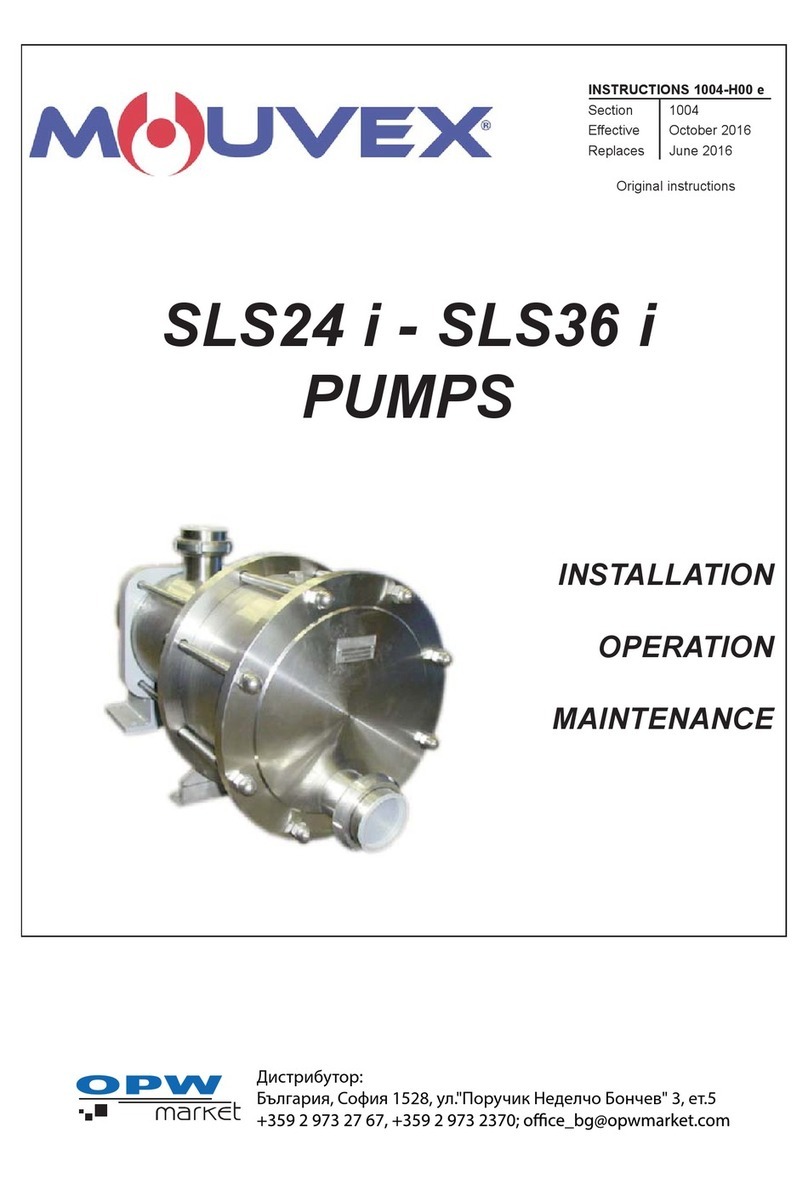
Mouvex
Mouvex SLS24 i Owner's manual
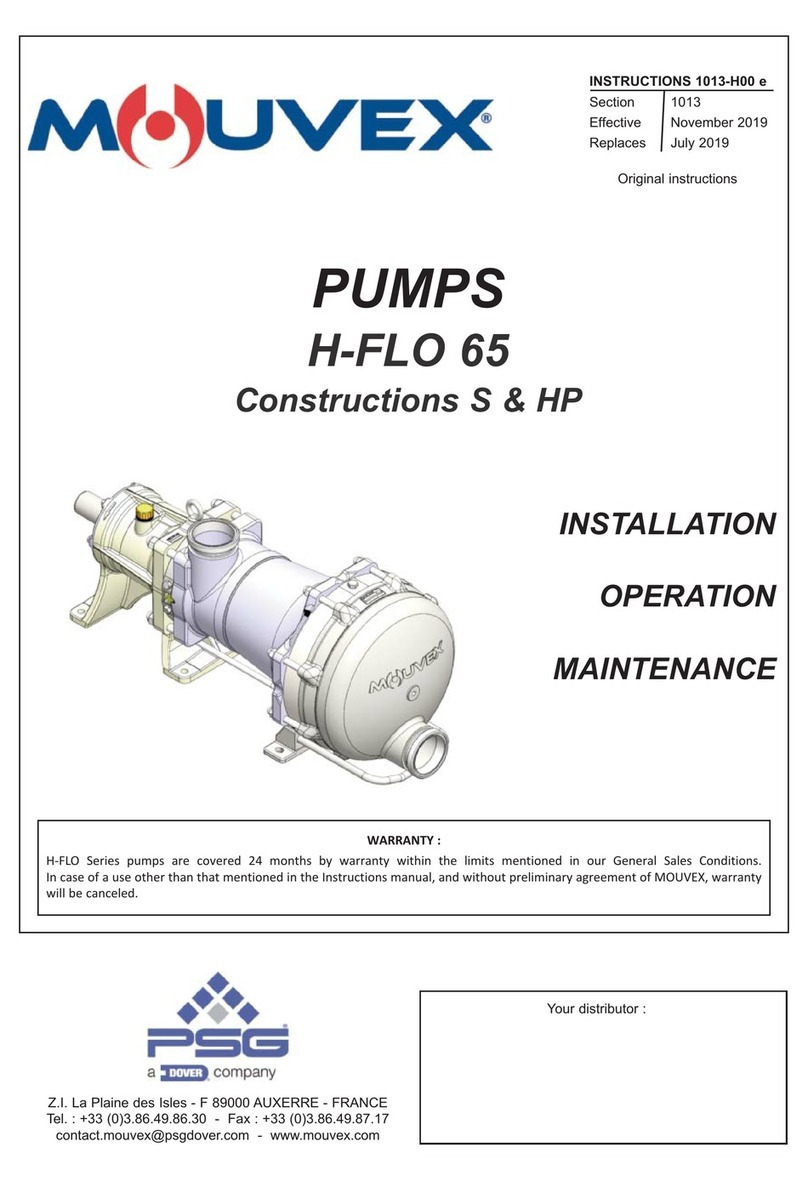
Mouvex
Mouvex H-FLO 65 Owner's manual
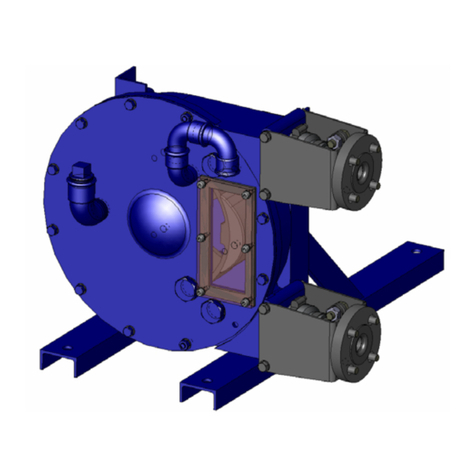
Mouvex
Mouvex AS25 Owner's manual
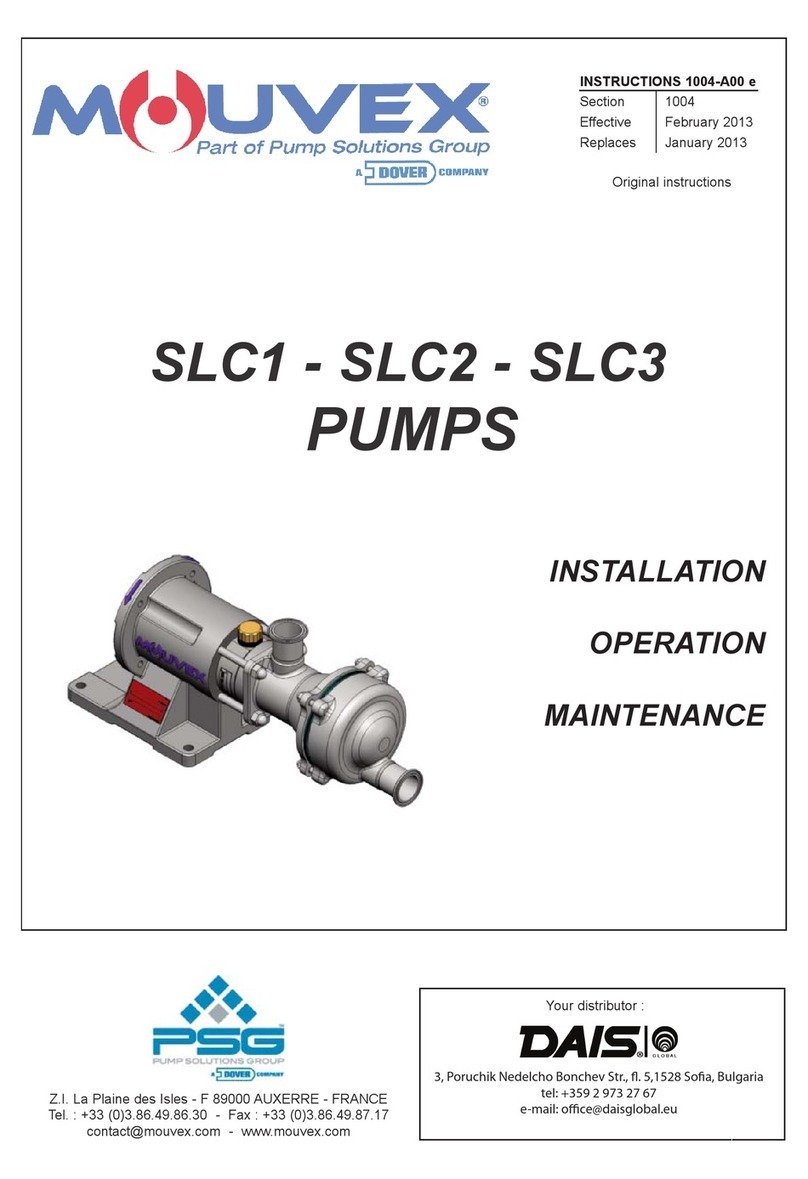
Mouvex
Mouvex SLC1 Owner's manual

Mouvex
Mouvex SLC24 i Owner's manual

Mouvex
Mouvex AK Series Guide
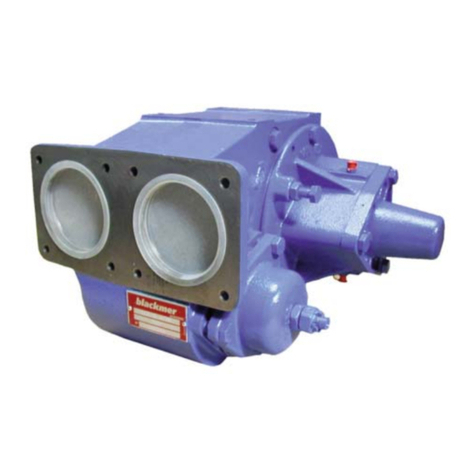
Mouvex
Mouvex CC8-40 AP Owner's manual
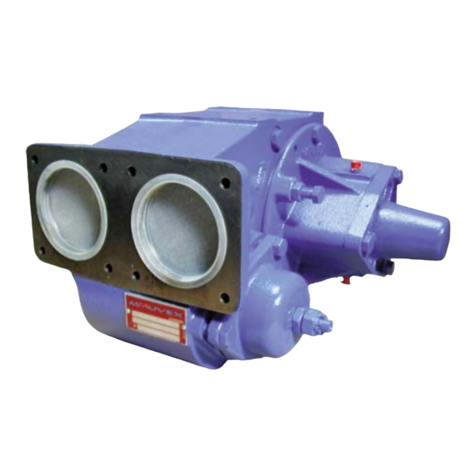
Mouvex
Mouvex CC8-40 Owner's manual
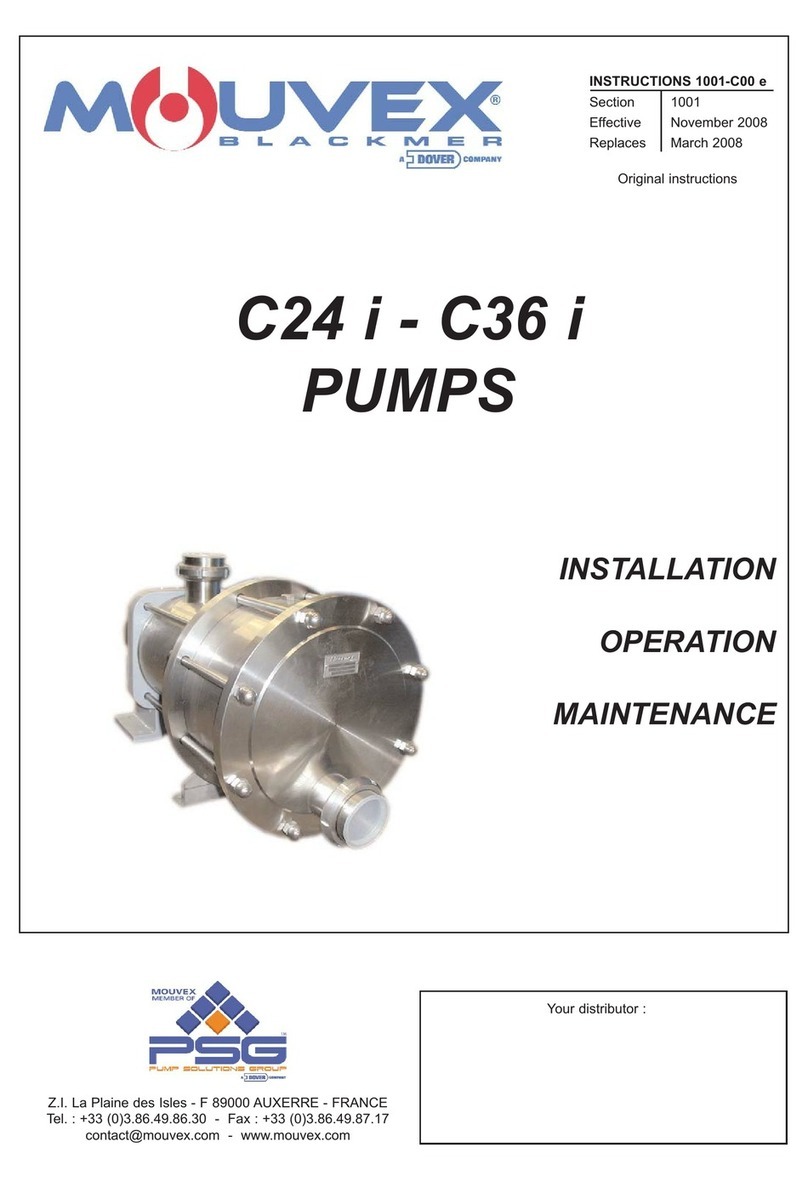
Mouvex
Mouvex C24 i Owner's manual
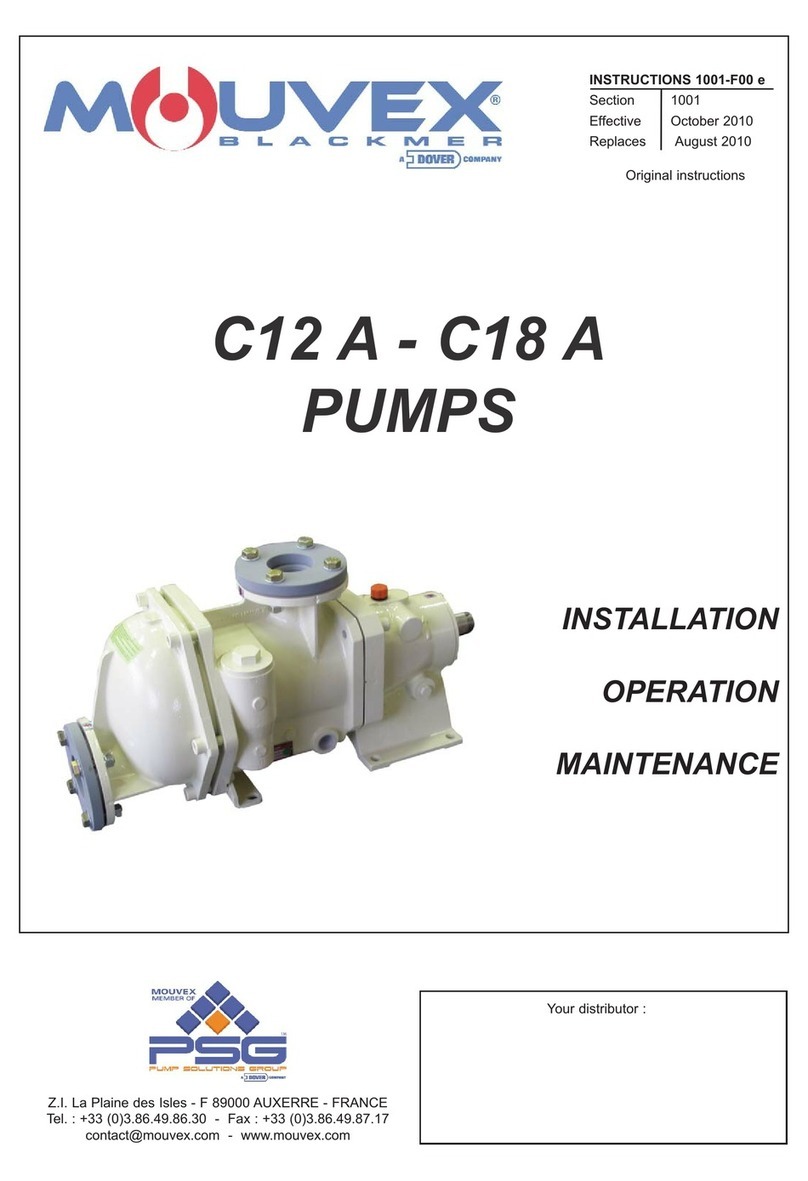
Mouvex
Mouvex C12 A Owner's manual
Popular Water Pump manuals by other brands

Oase
Oase AquaMax Eco Twin 20000 operating instructions

KSB
KSB MEGAFLOW 50-160 Operating instructions manual
Silicon Solar
Silicon Solar AquaJet-Pro-PUMP1224 user manual
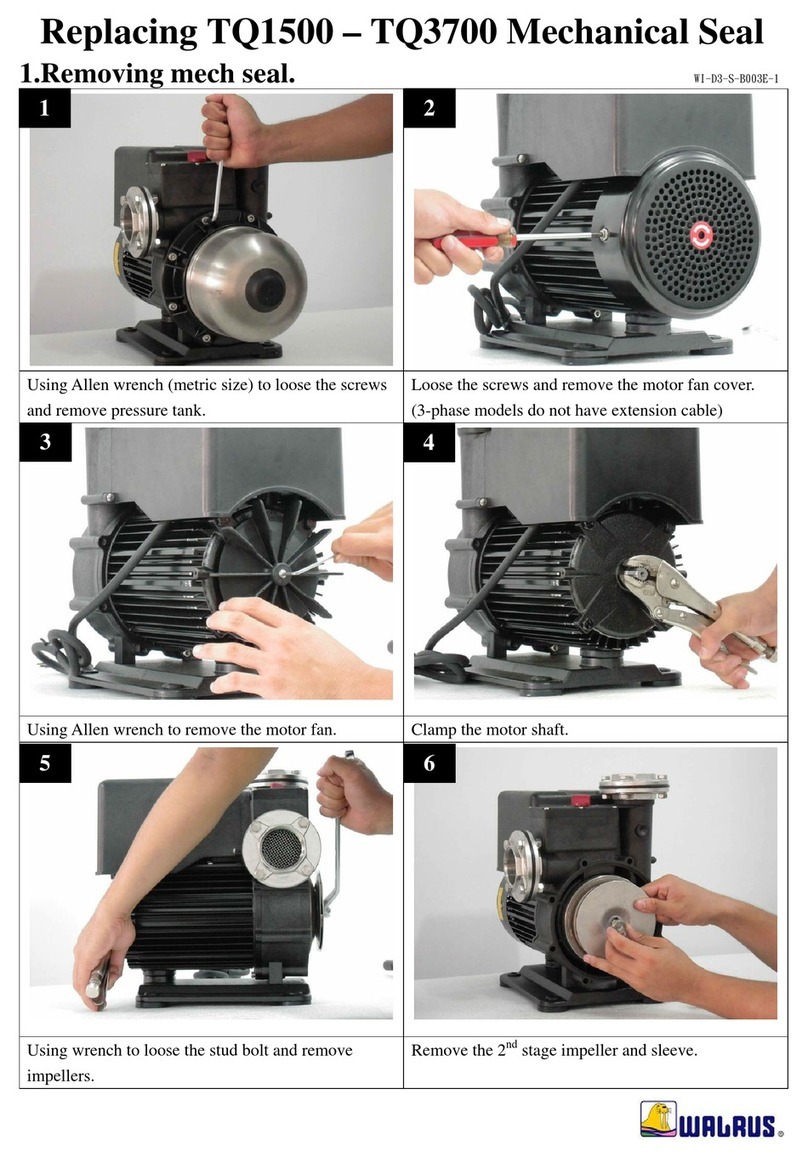
Walrus
Walrus TQ1500 Replacing

ULTIMATE SPEED
ULTIMATE SPEED KH 4256 Original operating instructions
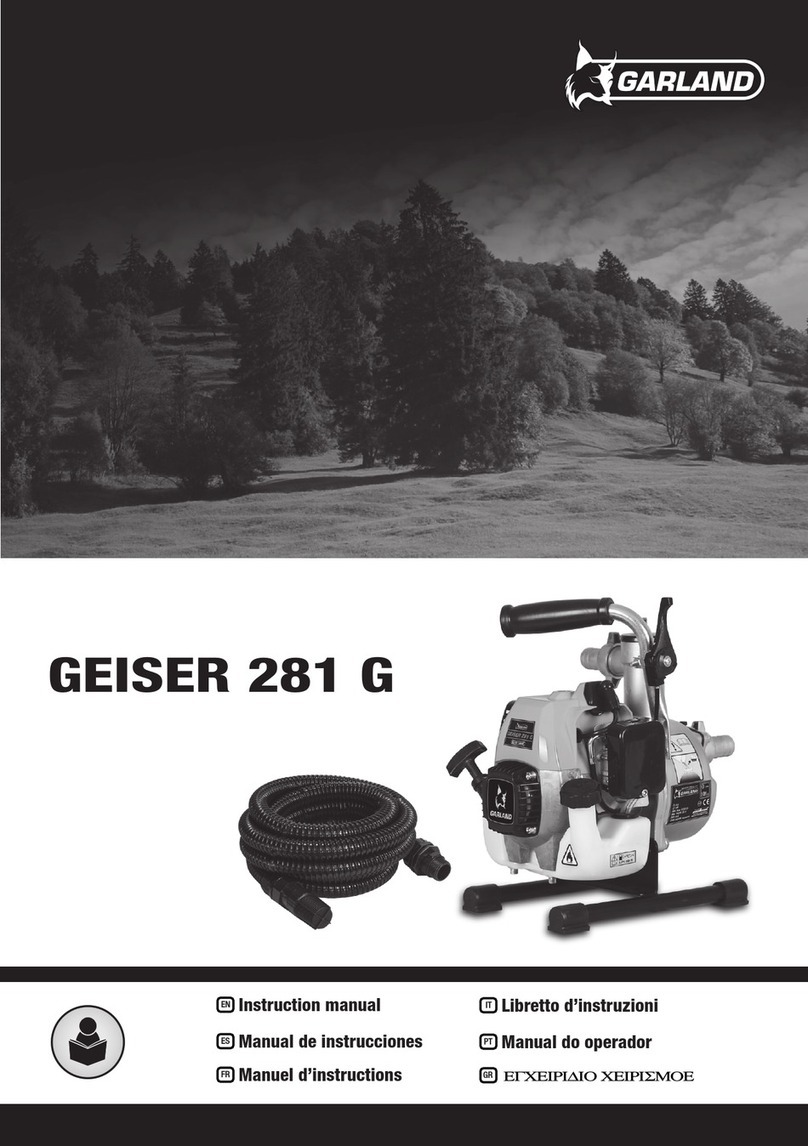
Garland
Garland GEISER 281 G instruction manual
